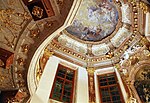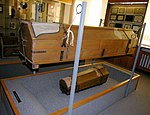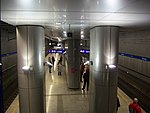Palais Lanckoroński

The Palais Lanckoroński was a palace in Vienna, Austria, located at Jacquingasse 16-18, in the Landstraße District. It was constructed in 1894-95 for Count Karol Lanckoroński and his family as a personal residence, and it housed the count's enormous art collection. The palace was built in a neo-baroque style by the theatre architects Ferdinand Fellner and Hermann Helmer. The building was three stories high, set back from the street, and protected by a wall with double gates. The entrance hall was wood panelled, two stories high, and decorated with portraits of the family. Other festive halls were decorated with frescoes and luxurious gobelin tapestries from the 17th century. Precious paintings, furniture and sculpture from different eras were arranged to form themed ensembles in the various rooms, with the rooms named to reflect the collection housed within. The palace was severely damaged in World War II, and was torn down in the 1960s.
Excerpt from the Wikipedia article Palais Lanckoroński (License: CC BY-SA 3.0, Authors, Images).Palais Lanckoroński
Jacquingasse, Vienna KG Landstraße (Landstraße)
Geographical coordinates (GPS) Address Phone number Website Nearby Places Show on map
Geographical coordinates (GPS)
| Latitude | Longitude |
|---|---|
| N 48.189166666667 ° | E 16.383333333333 ° |
Address
Botanischer Garten der Universität Wien
Jacquingasse
1030 Vienna, KG Landstraße (Landstraße)
Austria
Open on Google Maps











